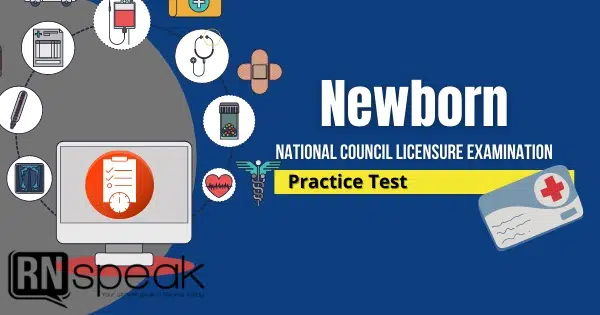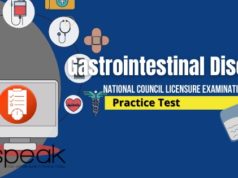
The physiology of newborns is fundamentally different than the physiology of older children and adults. Maybe the reason that it is different is it constantly changes, with the biggest change going out from the intrauterine and entering the extrauterine life. Newborn health is so important to families that the 2020 National Health Goals related to newborn health have been revised. Nurses play a major role in achieving these goals because nurses are uniquely suited to give care to newborns and newborn instruction to parents.
Read and analyze each question carefully and chose the best answer/s from the choices provided. At the end of these practice tests, correct answers along with the explanation are given.
Newborn Nursing NCLEX-RN Practice Questions
1. The nurse is caring for a newborn immediately after delivery. Which action by the nurse shows an understanding of the newborn’s thermoregulatory ability?
A. Suctions the newborn’s nostrils with a bulb syringe
B. Inspects the condition of the newborn’s umbilical cord
C. Places the newborn under a radiant warmer
D. Obtains an Apgar score during the first one and five minutes
2. During the assessment, the nurse notes a reddish stain on the diaper of a newborn. Which statement by the nurse shows an understanding of the cause of the stain?
A. “A newborn excretes excess bilirubin through their urine.”
B. “Excess iron is excreted by the newborn through their feces.”
C. “Mucus sometimes tends to be eliminated when the newborn defecates.”
D. “Uric acid crystals are excreted in the urine and stools of a newborn.”
3. The nurse is assessing the newborn’s heart rate while the newborn is asleep. Which result does the nurse consider a normal finding?
A. 100 beats per minute
B. 140 beats per minute
C. 80 beats per minute
D. 120 beats per minute
4. A parent brings a newborn into the healthcare clinic for a well-baby check-up. During the assessment of fontanelles, which findings by the nurse show a normal finding?
A. A bulging anterior fontanel; a sunken posterior fontanel
B. An anterior fontanel larger than the posterior fontanel
C. A diamond-shaped posterior; a triangular-shaped anterior
D. A posterior fontanel that is closed at 18 months
5. The nurse assesses a newborn’s reflexes. Which reflex can be assessed after birth and remain until adulthood?
A. Rooting reflex
B. Stepping reflex
C. Cough reflex
D. Moro reflex
6. The nurse observes that the newborn demonstrates the Babinski reflex. Which actions describe this reflex?
A. Dorsiflexion of the big toe and the foot
B. Deviation of the toes downward
C. Dorsiflexion of the foot and knee flexion
D. Dorsiflexion of the big toe and fanning of other toes
7. After birth, the nurse wants to maintain a neutral environment for the newborn. Which action is least effective to maintain a neutral environment?
A. Cover the weighing scale with a warmed blanket before weighing.
B. Cover the newborn’s head with a knitted head cap.
C. Place the crib close to the nursery window during family viewing.
D. Place the newborn under a radiant warmer after delivery.
8. Assessment of a newborn reveals an asymmetrical Moro reflex. Which action by the nurse is next?
A. Assess for increased intracranial pressure.
B. Test for congenital hypothyroidism.
C. Assess for talipes equinovarus.
D. Examine for a fractured clavicle.
9. The nurse is caring for a newborn who underwent circumcision. During the first four hours after the procedure, which nursing action is a priority?
A. Assessing for signs of hemorrhage.
B. Providing comfort to the newborn.
C. Administering intravenous fluids.
D. Preventing the development of infection.
10. Immediately after birth, the nurse observes that the newborn exhibits flaring nostrils, mild intercostal retractions, and grunting at the end of expiration. The newborn’s vital signs show that the respirations are 80 breaths per minute and a heart rate of 160 beats per minute. Which nursing action is appropriate for the assessment findings?
A. Administer oxygen at 2L/min via nasal cannula.
B. Inform the healthcare provider of the findings.
C. Suction the newborn’s mouth and nostrils.
D. Recognize that this is a normal finding.
11. The nurse provides discharge instructions to a mother about umbilical cord care. Which statement by the mother indicates effective health teaching?
A. “My child can have a tub bath every day.”
B. “I will clean the stump with antiseptics daily.”
C. “Water and soap can be used if the stump is dirty.”
D. “I need to apply an antibiotic ointment every day.”
12. The nurse is caring for a newborn who weighs 3800 grams and feeds every four hours. The newborn needs 110 kilocalories per kg of body weight every 24 hours. How many ounces of 20 kilocalories/oz formula does the nurse prepare for each feeding?
A. 3 ounces
B. 3.5 ounces
C. 4.5 ounces
D. 3.2 ounces
13. The nurse observes that the post-term newborn has meconium-stained amniotic fluid. Which nursing action is essential for this newborn?
A. Monitor the newborn’s bowel sounds.
B. Monitor the newborn’s respiratory rate.
C. Monitor the newborn’s skin.
D. Monitor the newborn’s intake and output.
14. The nurse prepares to administer vitamin K to a newborn. Which action by the nurse is correct?
A. Administers on the vastus lateralis muscle
B. Administers vitamin K orally
C. Administers vitamin K 24 hours after birth
D. Administers the medication before mother-baby interaction
15. A 2-day-old neonate is receiving phototherapy for jaundice. Which action is essential for the nurse to implement for this client?
A. Monitor the temperature carefully.
B. Instruct the mother to postpone breastfeeding.
C. Inform provider if the newborn’s stool turns bright green.
D. Avoid covering the newborn’s eyes during phototherapy.
16. The nurse suddenly bumps the bassinet of a newborn, eliciting the startle reflex. Which actions by the newborn show this reflex?
A. The big toe dorsiflexes, followed by fanning of the other toes.
B. The fingers flex to enclose the nurse’s fingers and cling.
C. The arms, legs, and neck extend then brings the arms together.
D. The head turns to one side, the aligned arm straightens, the opposite arm bends.
17. The nurse is caring for a newborn who underwent circumcision. During the assessment, the nurse notes a 2-cm circle of bright red bleeding in the newborn’s diaper. Which action by the nurse is next?
A. Inform the newborn’s healthcare provider immediately.
B. Tighten the diaper around the newborn’s waist.
C. Reassess the bleeding and affected site after 30 minutes.
D. Apply gentle pressure to the affected site with sterile gauze.
18. A mother states, “I think my baby likes to hear me talk.” Which response by the nurse is best?
A. “Babies are stimulated by low-pitched, monotonous sounds.”
B. “High-pitched speech with variations in tone best stimulate babies.”
C. “Cooing sounds, rather than words, stimulate babies most effectively.”
D. “The best way to stimulate babies with sound is by using repeatedly loud sounds.”
19. After delivery, a newborn is transported to the nursery. The nurse prepares to prevent hypothermia in the newborn. Which action increases radiant heat loss?
A. Avoid covering the weighing scale with a blanket or towel.
B. Move the newborn’s incubator closer to the viewing windows.
C. Decrease the room thermostat to a cooler temperature.
D. Place the newborn in a room with low humidity.
20. The nurse assesses the mother of a newborn who is breastfeeding. Which assessment finding indicates ineffective breastfeeding of the newborn?
A. The newborn’s mouth grasps the mother’s nipple with the tongue down.
B. The newborn swallows audibly, spontaneously, and frequently.
C. The newborn smacks their lips loudly during breastfeeding.
D. The newborn turns to the breast when its cheek is stroked with a nipple.
21. The nurse educates expectant parents regarding eye prophylaxis for the newborn. A father asks, “Which infectious diseases could be prevented by this treatment?” Which response by the nurse is best
A. “Prophylactic eye treatment for newborns helps prevent syphilis.”
B. “Sexually transmitted diseases such as gonorrhea can be avoided.”
C. “Herpes simplex can be prevented with prophylactic eye treatment.”
D. “Administration of eye antibiotics prevent the vertical spread of trichomonas.”
22. The nurse observes a mother breastfeeding her newborn and sees that the newborn is making frantic rooting motions but will not grasp the nipple. Which action by the nurse is best?
A. Instruct the mother to pause feeding and comfort the newborn.
B. Encourage the use of a pacifier to calm the newborn.
C. Firmly hold the newborn’s head against the breast until it latches.
D. Allow the newborn to be fed by formula, then try to breastfeed again.
23. After a vaginal delivery, the nurse assesses a large-for-gestational-age (LGA) newborn and finds that the axillary temperature is 96℉ (35.6℃) and the newborn’s lips and hands are trembling. Which action by the nurse is next?
A. Wrap the newborn in warm blankets.
B. Feed the newborn with formula.
C. Obtain serum glucose level.
D. Stimulate the newborn to cry.
24. The nurse educates a mother regarding the limitations of breastfeeding her newborn. Which statement by the mother indicates an understanding of the teaching?
A. “I may drink alcohol a few hours before breastfeeding my baby.”
B. “My breast milk won’t be affected by cigarette smoking.”
C. “I need to stop breastfeeding if my nipples become sore.”
D. “Consistent breastfeeding stops ovulation and my period.”
25. During the assessment of a 14-month-old infant, the nurse notes that the anterior fontanel is still open. Which action by the nurse is best?
A. Switch to an intensive neurological examination.
B. Inform the healthcare provider immediately.
C. Refer the newborn to a developmental specialist.
D. Document the data as a normal assessment finding.
26. The nurse is providing health education to a mother regarding the introduction of solid foods to their infant. Which age will it be most appropriate to start with solid foods?
A. 2 months
B. 4 months
C. 9 months
D. 12 months
27. The nurse is caring for a newborn of a substance-abusing mother. Which developmental concern will the infant most likely develop?
A. Guilt
B. Shame
C. Inferiority
D. Mistrust
28. A mother asks the nurse about appropriate toys for their 5-month-old infant. Which response by the nurse is best?
A. “Your baby would appreciate playing with a teddy with colorful, button eyes.”
B. “Push and pull toys are the best toys to aid a 5-month-old who is learning to walk.”
C. “Small, colorful marbles would entice your baby’s eyes and help develop color differentiation.”
D. “The baby would enjoy playing with a colorful busy box with lots of knobs and knickknacks.”
29. A mother states to the nurse, “Every time I pick up my crying infant, I worry that I am spoiling her too much.” Which response by the nurse is best?
A. “Comforting a crying baby does not spoil her; they need to be held and cuddled.”
B. “You can let your baby cry for a few minutes before picking her up.”
C. “Just leave her alone; she will learn to stop crying eventually,”
D. “A crying infant only means two things: they are hungry, or they need a diaper change.”
30. The nurse is performing a neurodevelopmental assessment on a three-month-old infant. Which assessment finding does not nurse expect?
A. A strong rooting reflex
B. Rolling from front to back
C. Lifting head and chest when prone
D. A strong grasping reflex







![Saudi Council Exam for Nurses [ Set 1] saudi council exam for nurses](https://rnspeak.com/wp-content/uploads/2021/08/saudi-council-exam-for-nurses-238x178.jpg)